Report on Nissan's Business Strategies, Expansion and Value Chain
VerifiedAdded on 2023/06/05
|9
|1964
|413
Report
AI Summary
This report examines Nissan's business strategies with a focus on market expansion, particularly since 1933, highlighting key milestones and strategic shifts. It details Nissan's emphasis on zero-emission vehicles through collaboration with Renault and various governments, and its efforts to establish sustainable mobility solutions. The analysis includes a value chain assessment, covering inbound logistics, operations across 63 production facilities, and outbound logistics with expanding retail networks. The report concludes that Nissan's adaptability and customer-focused approach have driven its growth, emphasizing the importance of stakeholder understanding and strategic human resource management for continued success. Desklib provides similar solved assignments for students.

Running Head: Nissan Business Strategies
Nissan Business Strategies
Name of the Student
Name of the Universities
Author’s Note
Nissan Business Strategies
Name of the Student
Name of the Universities
Author’s Note
Paraphrase This Document
Need a fresh take? Get an instant paraphrase of this document with our AI Paraphraser

2
Nissan Business Strategies
Table of Contents
Introduction......................................................................................................................................3
Business Strategy.............................................................................................................................4
Value chain analysis........................................................................................................................5
Conclusion.......................................................................................................................................7
References........................................................................................................................................8
Nissan Business Strategies
Table of Contents
Introduction......................................................................................................................................3
Business Strategy.............................................................................................................................4
Value chain analysis........................................................................................................................5
Conclusion.......................................................................................................................................7
References........................................................................................................................................8
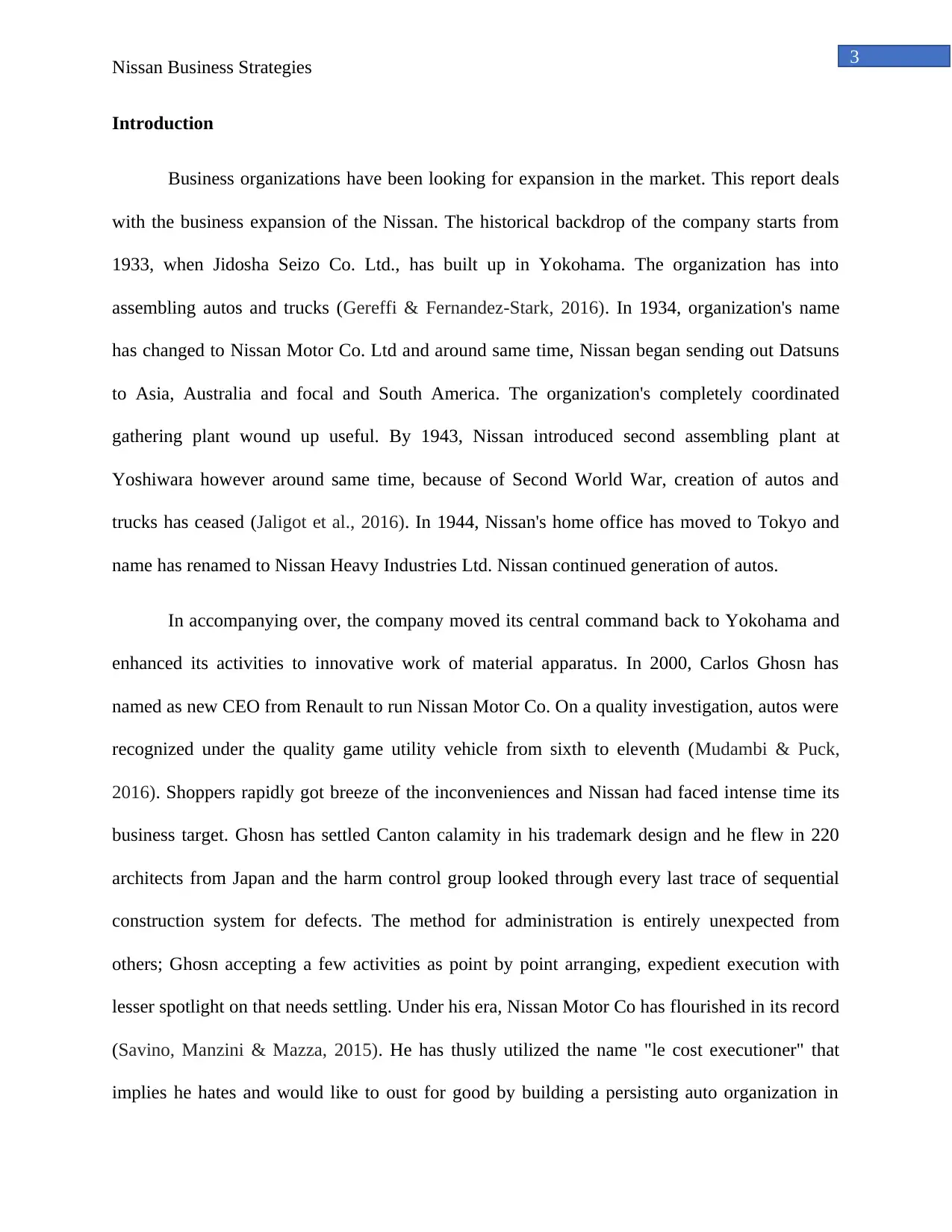
3
Nissan Business Strategies
Introduction
Business organizations have been looking for expansion in the market. This report deals
with the business expansion of the Nissan. The historical backdrop of the company starts from
1933, when Jidosha Seizo Co. Ltd., has built up in Yokohama. The organization has into
assembling autos and trucks (Gereffi & Fernandez-Stark, 2016). In 1934, organization's name
has changed to Nissan Motor Co. Ltd and around same time, Nissan began sending out Datsuns
to Asia, Australia and focal and South America. The organization's completely coordinated
gathering plant wound up useful. By 1943, Nissan introduced second assembling plant at
Yoshiwara however around same time, because of Second World War, creation of autos and
trucks has ceased (Jaligot et al., 2016). In 1944, Nissan's home office has moved to Tokyo and
name has renamed to Nissan Heavy Industries Ltd. Nissan continued generation of autos.
In accompanying over, the company moved its central command back to Yokohama and
enhanced its activities to innovative work of material apparatus. In 2000, Carlos Ghosn has
named as new CEO from Renault to run Nissan Motor Co. On a quality investigation, autos were
recognized under the quality game utility vehicle from sixth to eleventh (Mudambi & Puck,
2016). Shoppers rapidly got breeze of the inconveniences and Nissan had faced intense time its
business target. Ghosn has settled Canton calamity in his trademark design and he flew in 220
architects from Japan and the harm control group looked through every last trace of sequential
construction system for defects. The method for administration is entirely unexpected from
others; Ghosn accepting a few activities as point by point arranging, expedient execution with
lesser spotlight on that needs settling. Under his era, Nissan Motor Co has flourished in its record
(Savino, Manzini & Mazza, 2015). He has thusly utilized the name "le cost executioner" that
implies he hates and would like to oust for good by building a persisting auto organization in
Nissan Business Strategies
Introduction
Business organizations have been looking for expansion in the market. This report deals
with the business expansion of the Nissan. The historical backdrop of the company starts from
1933, when Jidosha Seizo Co. Ltd., has built up in Yokohama. The organization has into
assembling autos and trucks (Gereffi & Fernandez-Stark, 2016). In 1934, organization's name
has changed to Nissan Motor Co. Ltd and around same time, Nissan began sending out Datsuns
to Asia, Australia and focal and South America. The organization's completely coordinated
gathering plant wound up useful. By 1943, Nissan introduced second assembling plant at
Yoshiwara however around same time, because of Second World War, creation of autos and
trucks has ceased (Jaligot et al., 2016). In 1944, Nissan's home office has moved to Tokyo and
name has renamed to Nissan Heavy Industries Ltd. Nissan continued generation of autos.
In accompanying over, the company moved its central command back to Yokohama and
enhanced its activities to innovative work of material apparatus. In 2000, Carlos Ghosn has
named as new CEO from Renault to run Nissan Motor Co. On a quality investigation, autos were
recognized under the quality game utility vehicle from sixth to eleventh (Mudambi & Puck,
2016). Shoppers rapidly got breeze of the inconveniences and Nissan had faced intense time its
business target. Ghosn has settled Canton calamity in his trademark design and he flew in 220
architects from Japan and the harm control group looked through every last trace of sequential
construction system for defects. The method for administration is entirely unexpected from
others; Ghosn accepting a few activities as point by point arranging, expedient execution with
lesser spotlight on that needs settling. Under his era, Nissan Motor Co has flourished in its record
(Savino, Manzini & Mazza, 2015). He has thusly utilized the name "le cost executioner" that
implies he hates and would like to oust for good by building a persisting auto organization in
⊘ This is a preview!⊘
Do you want full access?
Subscribe today to unlock all pages.

Trusted by 1+ million students worldwide
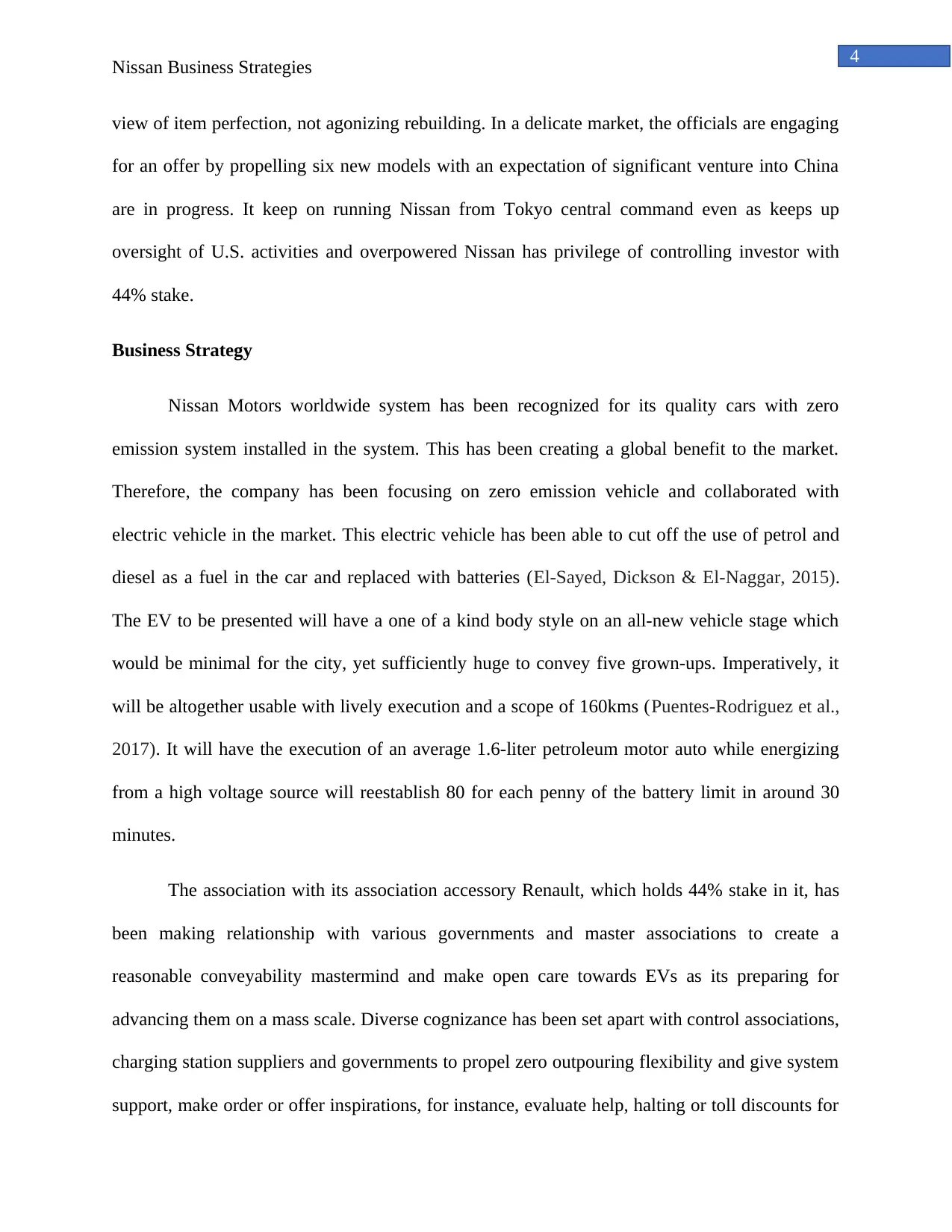
4
Nissan Business Strategies
view of item perfection, not agonizing rebuilding. In a delicate market, the officials are engaging
for an offer by propelling six new models with an expectation of significant venture into China
are in progress. It keep on running Nissan from Tokyo central command even as keeps up
oversight of U.S. activities and overpowered Nissan has privilege of controlling investor with
44% stake.
Business Strategy
Nissan Motors worldwide system has been recognized for its quality cars with zero
emission system installed in the system. This has been creating a global benefit to the market.
Therefore, the company has been focusing on zero emission vehicle and collaborated with
electric vehicle in the market. This electric vehicle has been able to cut off the use of petrol and
diesel as a fuel in the car and replaced with batteries (El-Sayed, Dickson & El-Naggar, 2015).
The EV to be presented will have a one of a kind body style on an all-new vehicle stage which
would be minimal for the city, yet sufficiently huge to convey five grown-ups. Imperatively, it
will be altogether usable with lively execution and a scope of 160kms (Puentes-Rodriguez et al.,
2017). It will have the execution of an average 1.6-liter petroleum motor auto while energizing
from a high voltage source will reestablish 80 for each penny of the battery limit in around 30
minutes.
The association with its association accessory Renault, which holds 44% stake in it, has
been making relationship with various governments and master associations to create a
reasonable conveyability mastermind and make open care towards EVs as its preparing for
advancing them on a mass scale. Diverse cognizance has been set apart with control associations,
charging station suppliers and governments to propel zero outpouring flexibility and give system
support, make order or offer inspirations, for instance, evaluate help, halting or toll discounts for
Nissan Business Strategies
view of item perfection, not agonizing rebuilding. In a delicate market, the officials are engaging
for an offer by propelling six new models with an expectation of significant venture into China
are in progress. It keep on running Nissan from Tokyo central command even as keeps up
oversight of U.S. activities and overpowered Nissan has privilege of controlling investor with
44% stake.
Business Strategy
Nissan Motors worldwide system has been recognized for its quality cars with zero
emission system installed in the system. This has been creating a global benefit to the market.
Therefore, the company has been focusing on zero emission vehicle and collaborated with
electric vehicle in the market. This electric vehicle has been able to cut off the use of petrol and
diesel as a fuel in the car and replaced with batteries (El-Sayed, Dickson & El-Naggar, 2015).
The EV to be presented will have a one of a kind body style on an all-new vehicle stage which
would be minimal for the city, yet sufficiently huge to convey five grown-ups. Imperatively, it
will be altogether usable with lively execution and a scope of 160kms (Puentes-Rodriguez et al.,
2017). It will have the execution of an average 1.6-liter petroleum motor auto while energizing
from a high voltage source will reestablish 80 for each penny of the battery limit in around 30
minutes.
The association with its association accessory Renault, which holds 44% stake in it, has
been making relationship with various governments and master associations to create a
reasonable conveyability mastermind and make open care towards EVs as its preparing for
advancing them on a mass scale. Diverse cognizance has been set apart with control associations,
charging station suppliers and governments to propel zero outpouring flexibility and give system
support, make order or offer inspirations, for instance, evaluate help, halting or toll discounts for
Paraphrase This Document
Need a fresh take? Get an instant paraphrase of this document with our AI Paraphraser
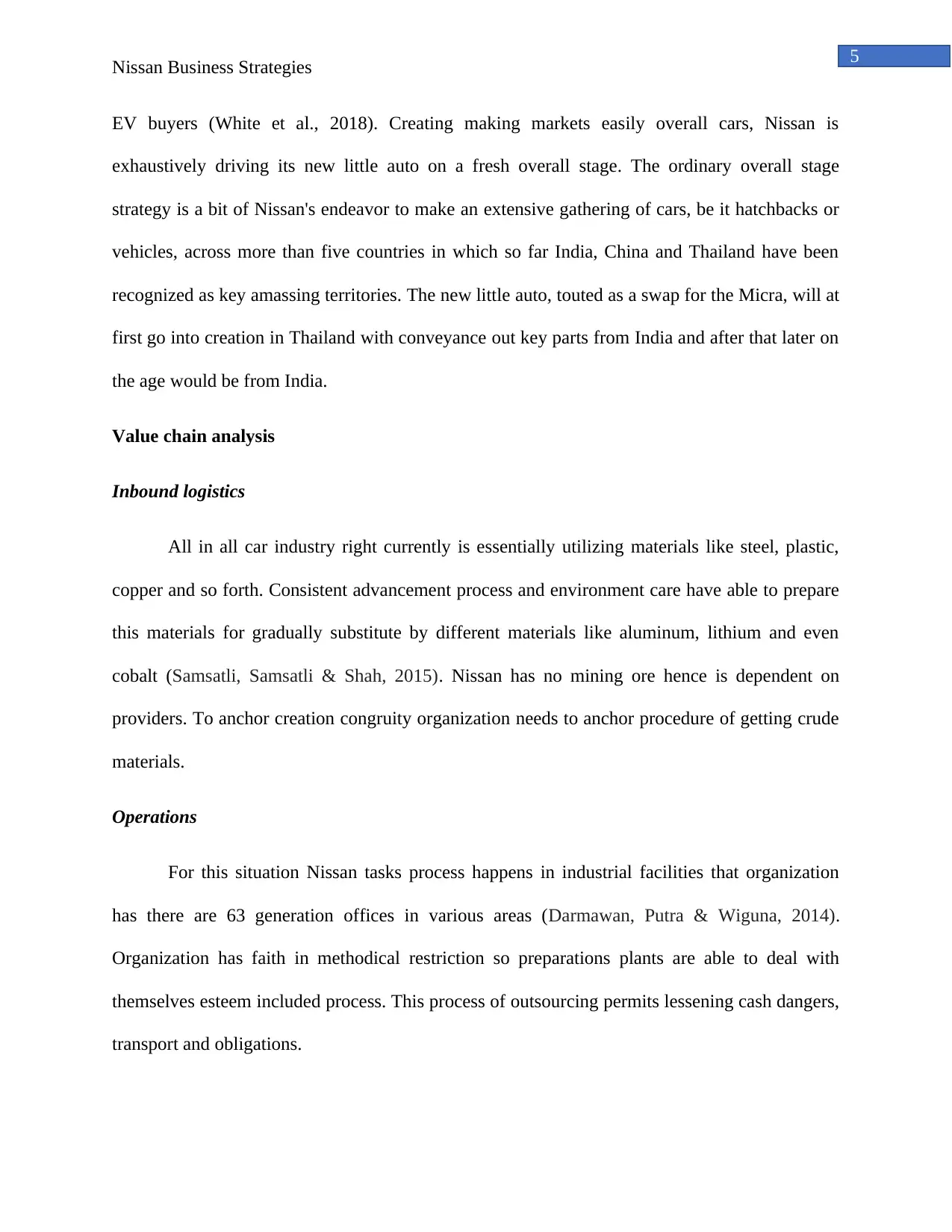
5
Nissan Business Strategies
EV buyers (White et al., 2018). Creating making markets easily overall cars, Nissan is
exhaustively driving its new little auto on a fresh overall stage. The ordinary overall stage
strategy is a bit of Nissan's endeavor to make an extensive gathering of cars, be it hatchbacks or
vehicles, across more than five countries in which so far India, China and Thailand have been
recognized as key amassing territories. The new little auto, touted as a swap for the Micra, will at
first go into creation in Thailand with conveyance out key parts from India and after that later on
the age would be from India.
Value chain analysis
Inbound logistics
All in all car industry right currently is essentially utilizing materials like steel, plastic,
copper and so forth. Consistent advancement process and environment care have able to prepare
this materials for gradually substitute by different materials like aluminum, lithium and even
cobalt (Samsatli, Samsatli & Shah, 2015). Nissan has no mining ore hence is dependent on
providers. To anchor creation congruity organization needs to anchor procedure of getting crude
materials.
Operations
For this situation Nissan tasks process happens in industrial facilities that organization
has there are 63 generation offices in various areas (Darmawan, Putra & Wiguna, 2014).
Organization has faith in methodical restriction so preparations plants are able to deal with
themselves esteem included process. This process of outsourcing permits lessening cash dangers,
transport and obligations.
Nissan Business Strategies
EV buyers (White et al., 2018). Creating making markets easily overall cars, Nissan is
exhaustively driving its new little auto on a fresh overall stage. The ordinary overall stage
strategy is a bit of Nissan's endeavor to make an extensive gathering of cars, be it hatchbacks or
vehicles, across more than five countries in which so far India, China and Thailand have been
recognized as key amassing territories. The new little auto, touted as a swap for the Micra, will at
first go into creation in Thailand with conveyance out key parts from India and after that later on
the age would be from India.
Value chain analysis
Inbound logistics
All in all car industry right currently is essentially utilizing materials like steel, plastic,
copper and so forth. Consistent advancement process and environment care have able to prepare
this materials for gradually substitute by different materials like aluminum, lithium and even
cobalt (Samsatli, Samsatli & Shah, 2015). Nissan has no mining ore hence is dependent on
providers. To anchor creation congruity organization needs to anchor procedure of getting crude
materials.
Operations
For this situation Nissan tasks process happens in industrial facilities that organization
has there are 63 generation offices in various areas (Darmawan, Putra & Wiguna, 2014).
Organization has faith in methodical restriction so preparations plants are able to deal with
themselves esteem included process. This process of outsourcing permits lessening cash dangers,
transport and obligations.
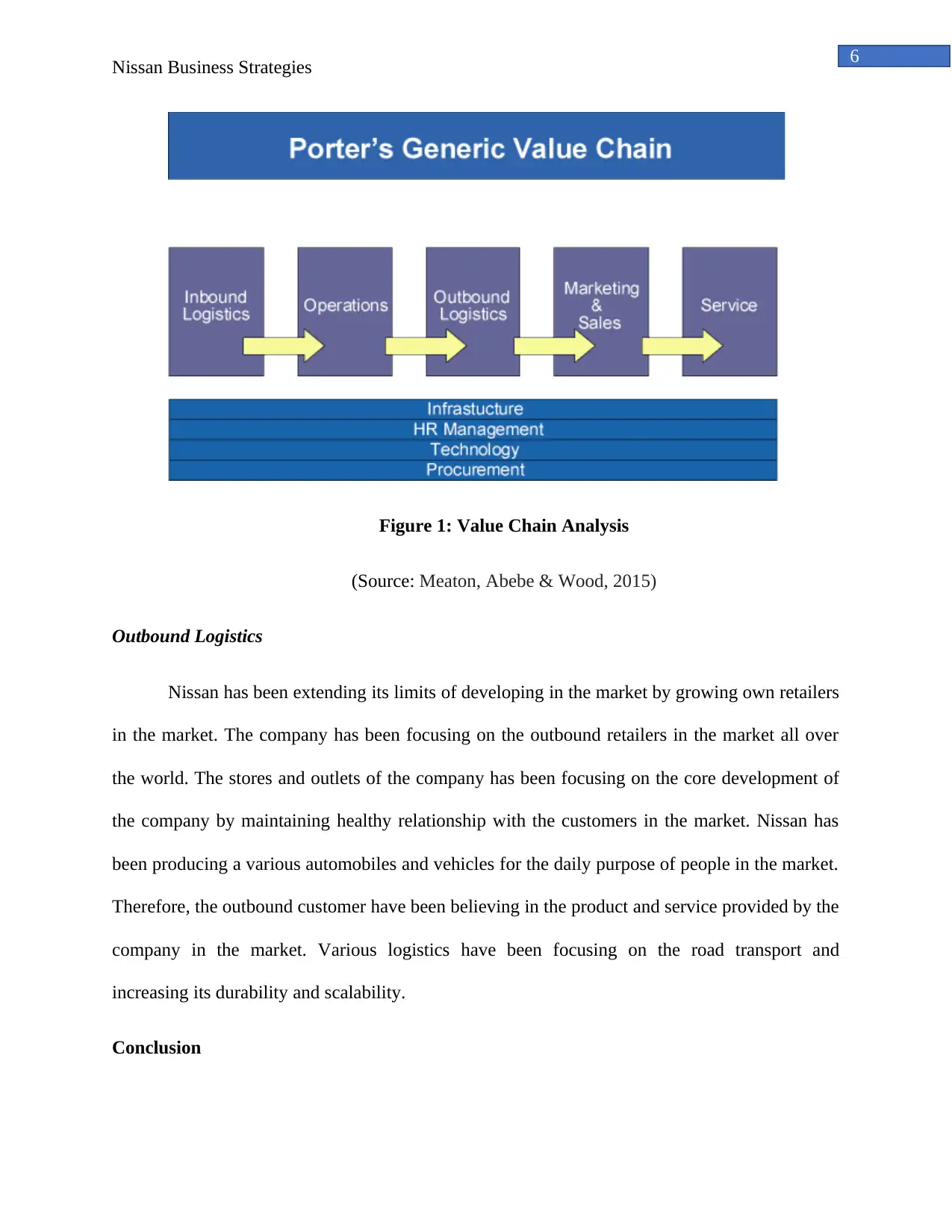
6
Nissan Business Strategies
Figure 1: Value Chain Analysis
(Source: Meaton, Abebe & Wood, 2015)
Outbound Logistics
Nissan has been extending its limits of developing in the market by growing own retailers
in the market. The company has been focusing on the outbound retailers in the market all over
the world. The stores and outlets of the company has been focusing on the core development of
the company by maintaining healthy relationship with the customers in the market. Nissan has
been producing a various automobiles and vehicles for the daily purpose of people in the market.
Therefore, the outbound customer have been believing in the product and service provided by the
company in the market. Various logistics have been focusing on the road transport and
increasing its durability and scalability.
Conclusion
Nissan Business Strategies
Figure 1: Value Chain Analysis
(Source: Meaton, Abebe & Wood, 2015)
Outbound Logistics
Nissan has been extending its limits of developing in the market by growing own retailers
in the market. The company has been focusing on the outbound retailers in the market all over
the world. The stores and outlets of the company has been focusing on the core development of
the company by maintaining healthy relationship with the customers in the market. Nissan has
been producing a various automobiles and vehicles for the daily purpose of people in the market.
Therefore, the outbound customer have been believing in the product and service provided by the
company in the market. Various logistics have been focusing on the road transport and
increasing its durability and scalability.
Conclusion
⊘ This is a preview!⊘
Do you want full access?
Subscribe today to unlock all pages.

Trusted by 1+ million students worldwide
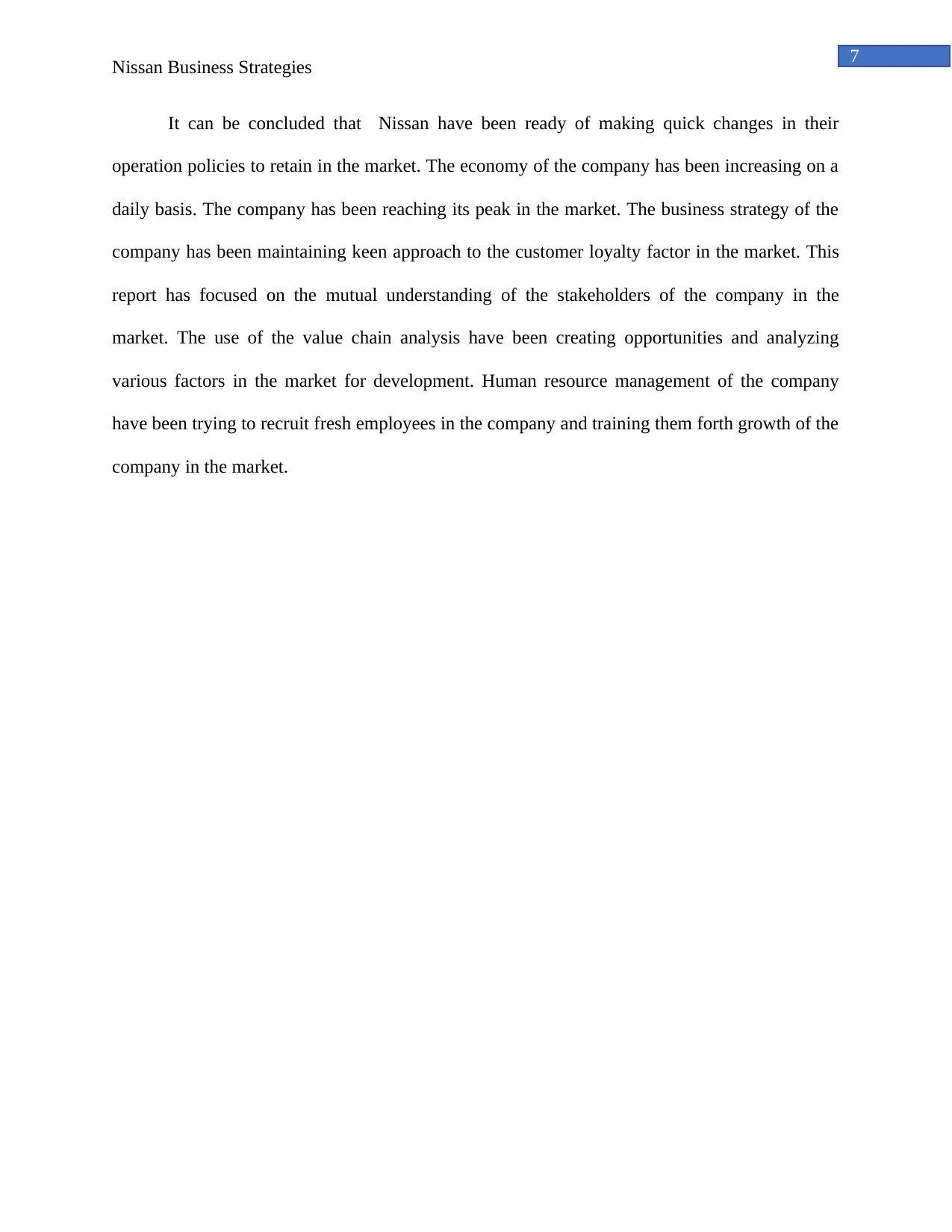
7
Nissan Business Strategies
It can be concluded that Nissan have been ready of making quick changes in their
operation policies to retain in the market. The economy of the company has been increasing on a
daily basis. The company has been reaching its peak in the market. The business strategy of the
company has been maintaining keen approach to the customer loyalty factor in the market. This
report has focused on the mutual understanding of the stakeholders of the company in the
market. The use of the value chain analysis have been creating opportunities and analyzing
various factors in the market for development. Human resource management of the company
have been trying to recruit fresh employees in the company and training them forth growth of the
company in the market.
Nissan Business Strategies
It can be concluded that Nissan have been ready of making quick changes in their
operation policies to retain in the market. The economy of the company has been increasing on a
daily basis. The company has been reaching its peak in the market. The business strategy of the
company has been maintaining keen approach to the customer loyalty factor in the market. This
report has focused on the mutual understanding of the stakeholders of the company in the
market. The use of the value chain analysis have been creating opportunities and analyzing
various factors in the market for development. Human resource management of the company
have been trying to recruit fresh employees in the company and training them forth growth of the
company in the market.
Paraphrase This Document
Need a fresh take? Get an instant paraphrase of this document with our AI Paraphraser
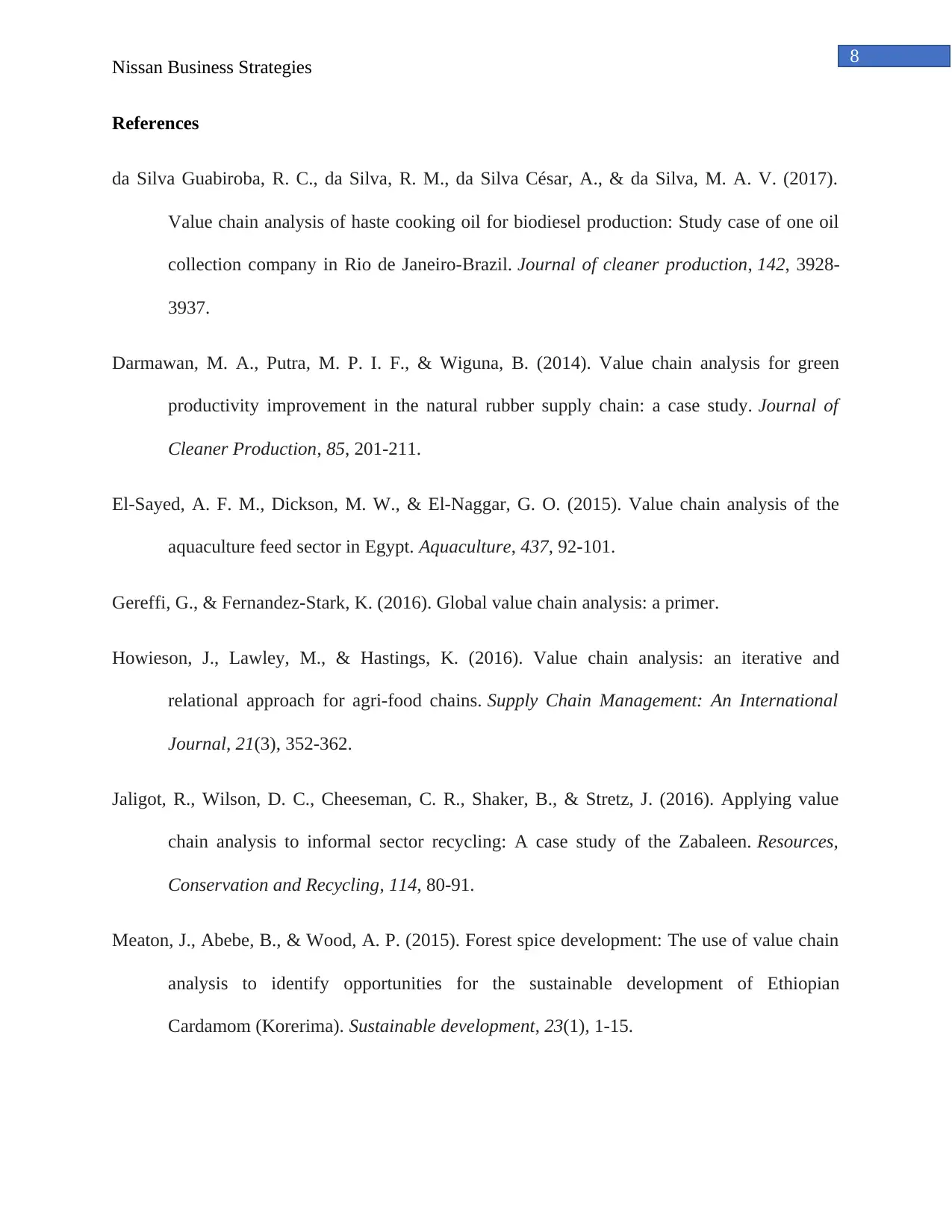
8
Nissan Business Strategies
References
da Silva Guabiroba, R. C., da Silva, R. M., da Silva César, A., & da Silva, M. A. V. (2017).
Value chain analysis of haste cooking oil for biodiesel production: Study case of one oil
collection company in Rio de Janeiro-Brazil. Journal of cleaner production, 142, 3928-
3937.
Darmawan, M. A., Putra, M. P. I. F., & Wiguna, B. (2014). Value chain analysis for green
productivity improvement in the natural rubber supply chain: a case study. Journal of
Cleaner Production, 85, 201-211.
El-Sayed, A. F. M., Dickson, M. W., & El-Naggar, G. O. (2015). Value chain analysis of the
aquaculture feed sector in Egypt. Aquaculture, 437, 92-101.
Gereffi, G., & Fernandez-Stark, K. (2016). Global value chain analysis: a primer.
Howieson, J., Lawley, M., & Hastings, K. (2016). Value chain analysis: an iterative and
relational approach for agri-food chains. Supply Chain Management: An International
Journal, 21(3), 352-362.
Jaligot, R., Wilson, D. C., Cheeseman, C. R., Shaker, B., & Stretz, J. (2016). Applying value
chain analysis to informal sector recycling: A case study of the Zabaleen. Resources,
Conservation and Recycling, 114, 80-91.
Meaton, J., Abebe, B., & Wood, A. P. (2015). Forest spice development: The use of value chain
analysis to identify opportunities for the sustainable development of Ethiopian
Cardamom (Korerima). Sustainable development, 23(1), 1-15.
Nissan Business Strategies
References
da Silva Guabiroba, R. C., da Silva, R. M., da Silva César, A., & da Silva, M. A. V. (2017).
Value chain analysis of haste cooking oil for biodiesel production: Study case of one oil
collection company in Rio de Janeiro-Brazil. Journal of cleaner production, 142, 3928-
3937.
Darmawan, M. A., Putra, M. P. I. F., & Wiguna, B. (2014). Value chain analysis for green
productivity improvement in the natural rubber supply chain: a case study. Journal of
Cleaner Production, 85, 201-211.
El-Sayed, A. F. M., Dickson, M. W., & El-Naggar, G. O. (2015). Value chain analysis of the
aquaculture feed sector in Egypt. Aquaculture, 437, 92-101.
Gereffi, G., & Fernandez-Stark, K. (2016). Global value chain analysis: a primer.
Howieson, J., Lawley, M., & Hastings, K. (2016). Value chain analysis: an iterative and
relational approach for agri-food chains. Supply Chain Management: An International
Journal, 21(3), 352-362.
Jaligot, R., Wilson, D. C., Cheeseman, C. R., Shaker, B., & Stretz, J. (2016). Applying value
chain analysis to informal sector recycling: A case study of the Zabaleen. Resources,
Conservation and Recycling, 114, 80-91.
Meaton, J., Abebe, B., & Wood, A. P. (2015). Forest spice development: The use of value chain
analysis to identify opportunities for the sustainable development of Ethiopian
Cardamom (Korerima). Sustainable development, 23(1), 1-15.
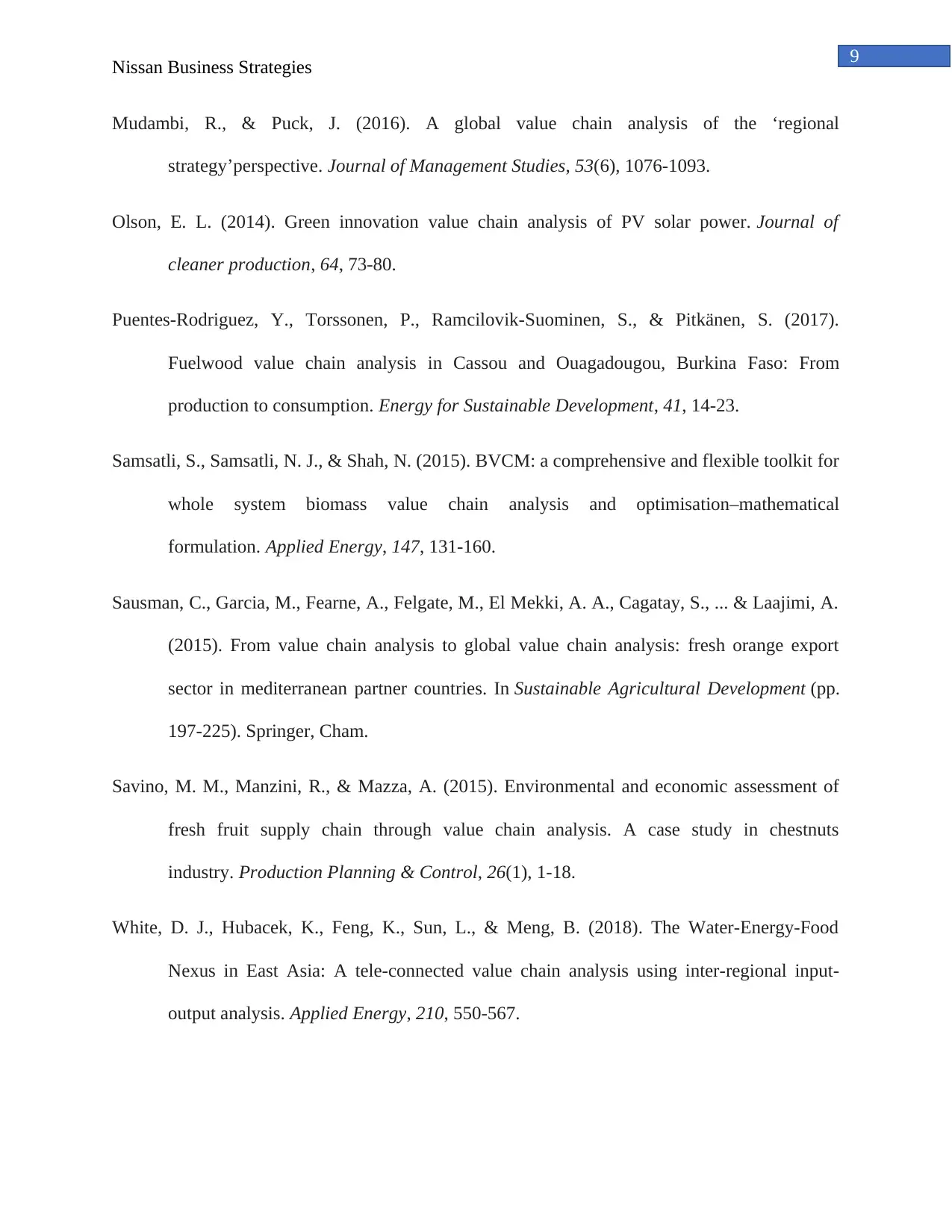
9
Nissan Business Strategies
Mudambi, R., & Puck, J. (2016). A global value chain analysis of the ‘regional
strategy’perspective. Journal of Management Studies, 53(6), 1076-1093.
Olson, E. L. (2014). Green innovation value chain analysis of PV solar power. Journal of
cleaner production, 64, 73-80.
Puentes-Rodriguez, Y., Torssonen, P., Ramcilovik-Suominen, S., & Pitkänen, S. (2017).
Fuelwood value chain analysis in Cassou and Ouagadougou, Burkina Faso: From
production to consumption. Energy for Sustainable Development, 41, 14-23.
Samsatli, S., Samsatli, N. J., & Shah, N. (2015). BVCM: a comprehensive and flexible toolkit for
whole system biomass value chain analysis and optimisation–mathematical
formulation. Applied Energy, 147, 131-160.
Sausman, C., Garcia, M., Fearne, A., Felgate, M., El Mekki, A. A., Cagatay, S., ... & Laajimi, A.
(2015). From value chain analysis to global value chain analysis: fresh orange export
sector in mediterranean partner countries. In Sustainable Agricultural Development (pp.
197-225). Springer, Cham.
Savino, M. M., Manzini, R., & Mazza, A. (2015). Environmental and economic assessment of
fresh fruit supply chain through value chain analysis. A case study in chestnuts
industry. Production Planning & Control, 26(1), 1-18.
White, D. J., Hubacek, K., Feng, K., Sun, L., & Meng, B. (2018). The Water-Energy-Food
Nexus in East Asia: A tele-connected value chain analysis using inter-regional input-
output analysis. Applied Energy, 210, 550-567.
Nissan Business Strategies
Mudambi, R., & Puck, J. (2016). A global value chain analysis of the ‘regional
strategy’perspective. Journal of Management Studies, 53(6), 1076-1093.
Olson, E. L. (2014). Green innovation value chain analysis of PV solar power. Journal of
cleaner production, 64, 73-80.
Puentes-Rodriguez, Y., Torssonen, P., Ramcilovik-Suominen, S., & Pitkänen, S. (2017).
Fuelwood value chain analysis in Cassou and Ouagadougou, Burkina Faso: From
production to consumption. Energy for Sustainable Development, 41, 14-23.
Samsatli, S., Samsatli, N. J., & Shah, N. (2015). BVCM: a comprehensive and flexible toolkit for
whole system biomass value chain analysis and optimisation–mathematical
formulation. Applied Energy, 147, 131-160.
Sausman, C., Garcia, M., Fearne, A., Felgate, M., El Mekki, A. A., Cagatay, S., ... & Laajimi, A.
(2015). From value chain analysis to global value chain analysis: fresh orange export
sector in mediterranean partner countries. In Sustainable Agricultural Development (pp.
197-225). Springer, Cham.
Savino, M. M., Manzini, R., & Mazza, A. (2015). Environmental and economic assessment of
fresh fruit supply chain through value chain analysis. A case study in chestnuts
industry. Production Planning & Control, 26(1), 1-18.
White, D. J., Hubacek, K., Feng, K., Sun, L., & Meng, B. (2018). The Water-Energy-Food
Nexus in East Asia: A tele-connected value chain analysis using inter-regional input-
output analysis. Applied Energy, 210, 550-567.
⊘ This is a preview!⊘
Do you want full access?
Subscribe today to unlock all pages.

Trusted by 1+ million students worldwide
1 out of 9
Related Documents
Your All-in-One AI-Powered Toolkit for Academic Success.
+13062052269
info@desklib.com
Available 24*7 on WhatsApp / Email
![[object Object]](/_next/static/media/star-bottom.7253800d.svg)
Unlock your academic potential
© 2024 | Zucol Services PVT LTD | All rights reserved.





